HOME|Ideas and resoueces for planetary science experiments|Daily Motion of Stars in the Southern Hemisphere
宇宙の実験教室
Ideas and resoueces for planetary science experiments
カテゴリ
Category
- 実験教室Idea and Resources for Space science experiments
- 対象項目別Category: Contents
- 学年単元別Category: Study Age
-
- 実践授業Activity Reports
タグ
Tag
 南半球で見られる星座
南半球で見られる星座
ねらい
地球上の緯度によって星の日周運動の見え方が変わることを理解しよう。
北極点と赤道上では星の日周運動の見え方は違います。緯度によっては見ることのできない星もあります。ここでは、図を使って天球の考え方を理解し、南半球でしか見られない星があることを確かめてみましょう。そして、南半球でしか見られない星座にはどんなものがあるのか、写真を見てみましょう。
日本から見た星の日周運動
夜、日本のどこか、よく星の見える場所から空の各方位の写真を撮ると、下のようになりましたね。
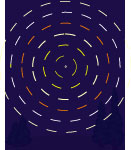 |
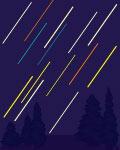 |
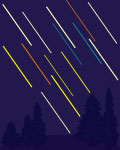 |
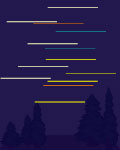 |
| 北の空 | 東の空 | 西の空 | 南の空 |
どの方位の写真?
では、これは東西南北どの方位の空の写真でしょう!?

「南の空?」東の空?!」「西の空??」「北の空???」 実は、この写真が地球上のどこで撮られたのかによって、答えは違ってきてしまうのですよ。
天球を理解しよう

地球のまわりを想像上の大きな球が囲んでいると仮定して、地球からいろいろな距離にある星をその球の表面に貼り付けます。こうして作った想像上の球形の天井を「天球(てんきゅう)」といいます。
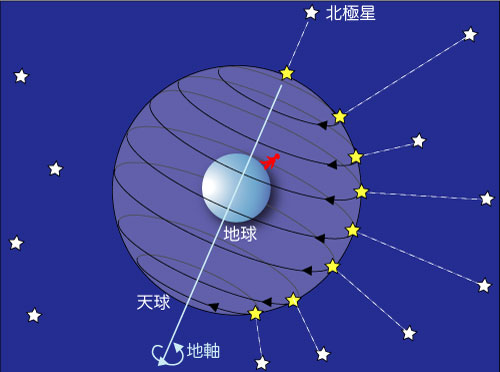
地球は図のように、北極星の方向を軸にして自転しているので、天球上の星は図のように、地球の自転の方向とは逆の方向に天球上を動いているように見えます。 これを地球上の北半球のある地点から見るとどうなるでしょうか。
天球の大きさと比べると、地球はずっと小さいので、天球の中心に小さく縮めてしまいましょう。すると下の図のようになりますね。
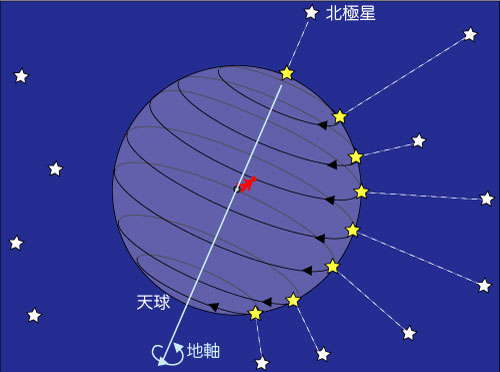
そこに立っている人の地面を天球の中に広げて作ってあげましょう。
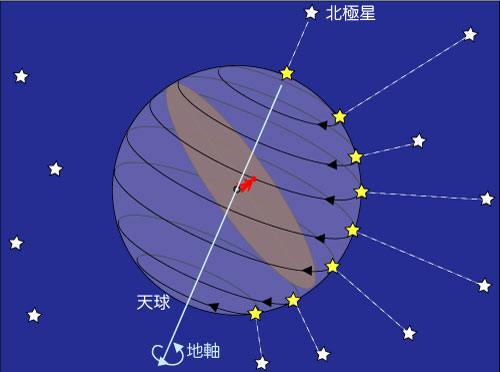
見やすくするために、地面を水平にするために、上の図を時計の針と反対方向に回転してみましょう。
すると、下の図のようになりますね。北極星の方向が北ですから、南・東・西の方位もどこになるのか分かりますね。
さあ、これで、北半球にいる人が見ている星空を示した天球の図ができました。
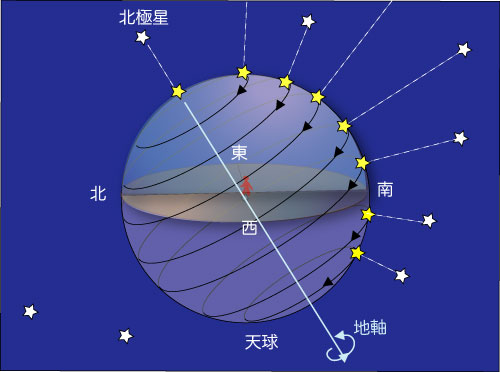
北半球で見られない星
下の図は北半球にいる人が見ている星空を示した天球です。 さて、ここで問題です!この図の中には、北半球にいる赤い人が見ることができない星があるのです。それは一体どこにある星でしょう?
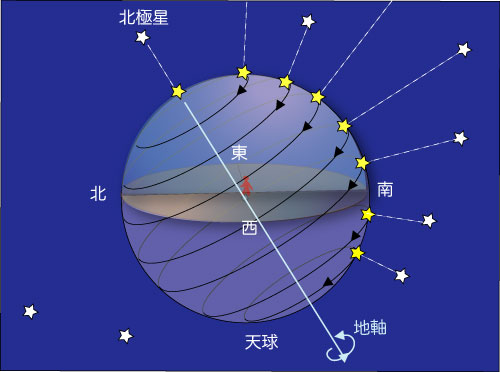
...わかりましたか?...そうです!下の図の赤くぬられた場所にある星ですね。
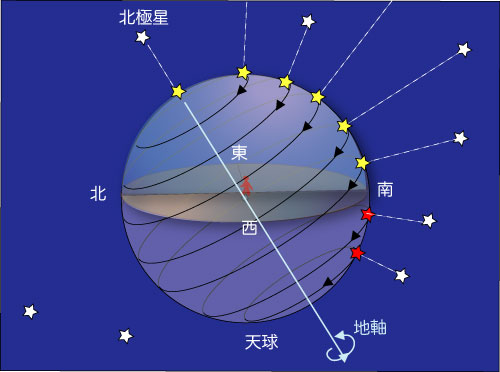
この赤い星は赤い人の立っている地面より上には出て来ませんね。だから、赤い人はこれらの星を見ることができないのです。
考えてみよう
下の図の地球上にいる赤い人を動かして、上の図の赤い場所にある星を見せてあげましょう。
地球上のどこに行ったら、見ることができるようになるかな?
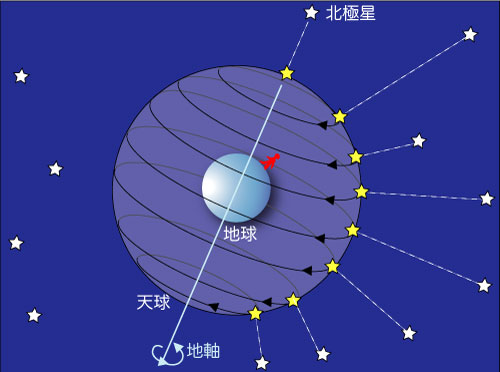
南半球から見た星の日周運動
赤い人を南半球に動かしてみましょう。
南半球では、下の図のような天球を見ていることになります。よって、北半球では見ることができない星(前のページの図で赤くぬられた星ですね)を見ることができます。
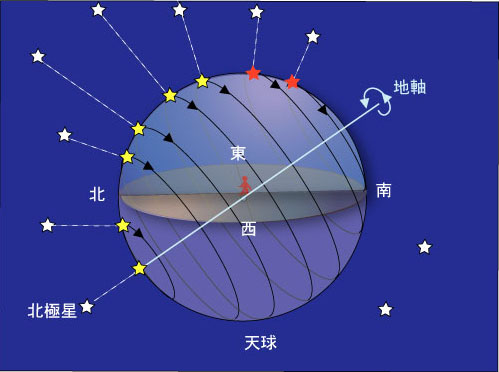
南半球から見た星の日周運動
上の天球の図から、南半球から見た空の各方位の写真は下のようになると考えられますね。
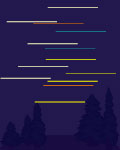 |
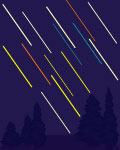 |
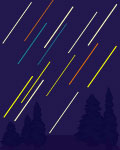 |
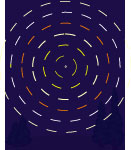 |
| 北の空 | 東の空 | 西の空 | 南の空 |
もっと考えてみよう
もっと考えてみよう
北極点から見た各方位の星の写真はどうなるでしょう?また,赤道上ではどうなるか、天球図から考えてみましょう。
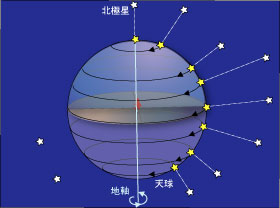 |
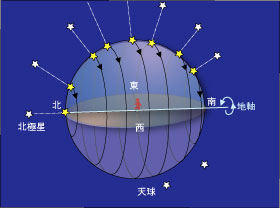 |
| 北極点から見た天球 | 赤道上から見た天球 |
北極点や赤道上から見た天球は上の図のようになります。 したがって、各方位の星の見え方は、次の図のようになります。
北極点から見た星の日周運動
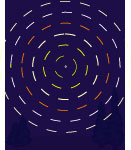 |
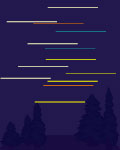 |
| 天頂 | まわり |
赤道上から見た星の日周運動
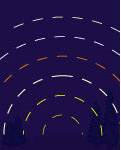 |
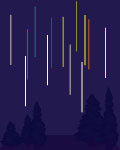 |
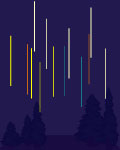 |
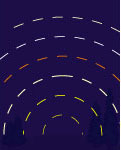 |
| 北の空 | 東の空 | 西の空 | 南の空 |
南半球で見られる星座
南半球で見られる星座にはどんなものがあるのか見てみましょう。
 |
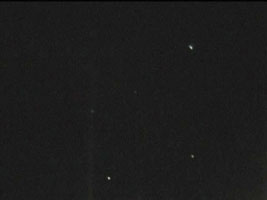 |
| 南十字星 | カノープス |
 Daily Motion of Stars in the Southern Hemisphere
Daily Motion of Stars in the Southern Hemisphere
Introduction
Here we explain that the observed daily motion of the stars varies depending on the observer's latitude
The motions of the stars across the sky as viewed from the North Pole and the Equator are quite different. Additionally, depending on observing latitude, certain stars will not be visible. With the aid of diagrams, we will explain the concept of the celestial sphere, and try to show that the stars with are not visible may be observed in southern hemisphere. Then we will show photographs of some of the constellations which are visible in the southern hemisphere
Motion of the Stars as viewed from Japan
Take pictures of the night sky from a location in Japan looking in several different directions.
 |
 |
 |
 |
| Northern Sky | Eastern Sky | Western Sky | Southern Sky |
Which Direction is the Observer Facing?
From a photo of the night sky below, is it possible to tell the direction!?

North? South?! East?? West???
In fact, the answer will be different depending on the location where the photograph was taken.
Understanding the Celestial Sphere
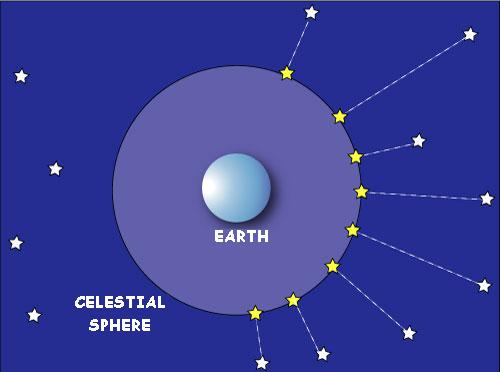
Let us imagine that the Earth is surrounded by a large sphere, as shown in the diagram above. In this diagram the stars, which are in reality a range of distances from the Earth, are attached to the surface of this sphere. In this way, an imaginary starry ceiling was devised to represent then night sky, known as the 'celestial sphere'.
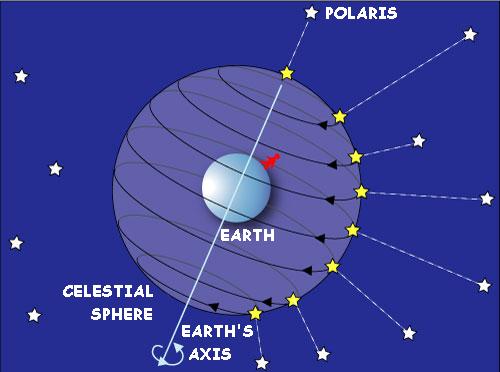
Because the Earth as shown above, rotates with the direction of the Polaris as an axis, the star with respect to the celestial sphere is visible as in the figure, as with respect to the celestial sphere been moving to the direction of opposite to the direction of rotation of the earth.
When you are observing the sky from a location the Earth's northern hemisphere, how will it appear?
The Earth is obviously very small compared with the size of the heavens, so it is better to represent our planet with a smaller sphere, as shown in the figure below.
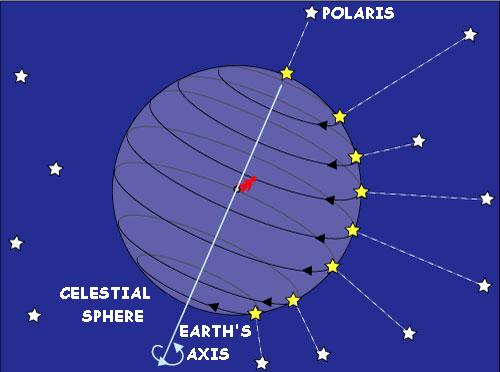
The observer will have part of the celestial sphere obscured by the Earth, so we place him on a flat surface covering the middle of the celestial sphere's interior, as shown below.
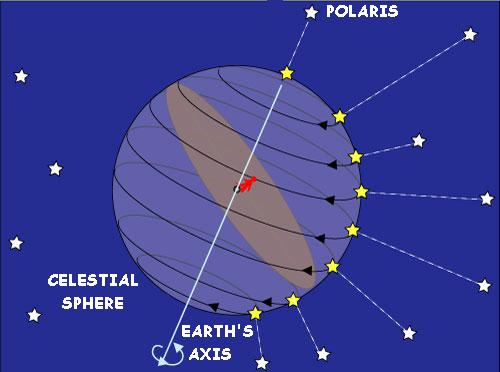
To best represent the observer's appearance of the sky, we will need to make the 'ground' horizontal, and rotate the celestial sphere in an anticlockwise direction, as shown below.
Since Polaris is in a northerly direction as viewed by the observer, we can then locate south, east and west in the diagram.
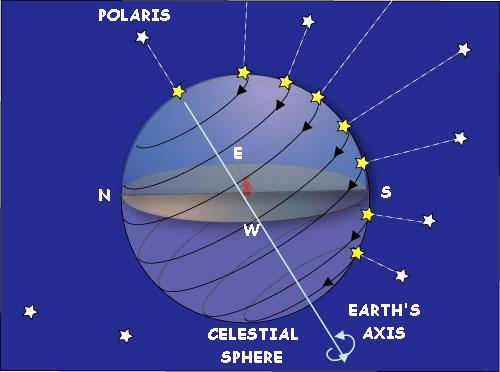
Stars not visible in the Northern Hemisphere
The figure below uses the celestial sphere to show the starry sky as viewed by a northern hemisphere observer (represented by the red person).
There is a problem here! Some of the stars on the celestial sphere are not visible to our observer. Which ones are they?
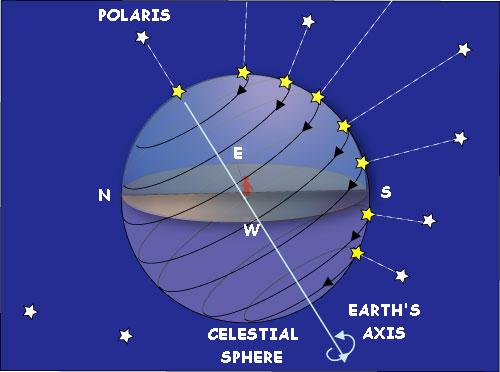
The invisible stars are below the observer- these are shown in red below.
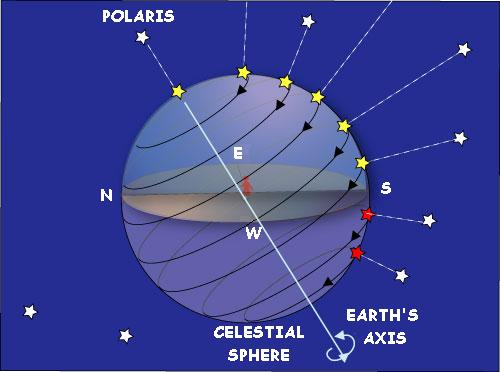
As you can see from the above figure, the red stars will be never above the ground. Our observer will never be able to see these stars.
Things to Think About
Move the observer's location on the surface of the Earth to determine from which location the red stars will be visible.
Where do you have to move the observer to?
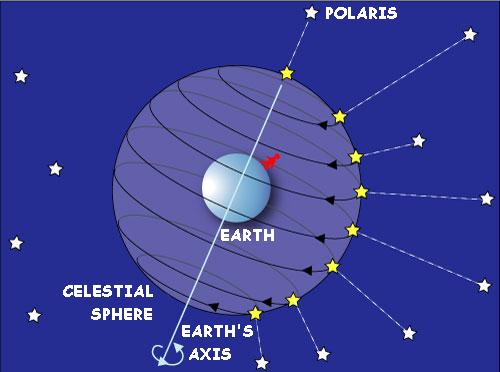
Southern Hemisphere Constellations
Let us move the red person to the southern hemisphere.
This will mean the Celestial Sphere appears as shown below. Now the stars which were not observable from the northern hemisphere (shown in red) are visible.
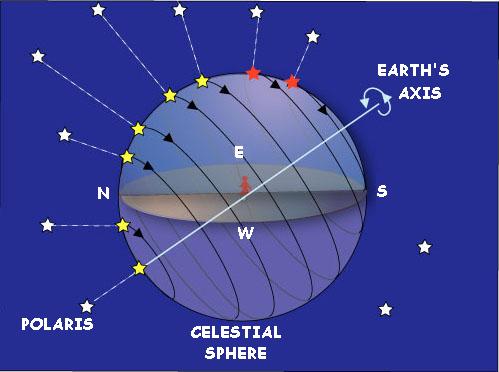
Motion of the Stars in the Southern Hemisphere
From the figure above, we can see that from the southern hemisphere, time exposure images of the stars from each direction will be as follows.
 |
 |
 |
 |
| North | East | West | South |
Further Discussion
Further Discussion
If we take images in each compass direction from the North Pole, what will they look like? Similarly, think about how the stars will appear as viewed from the Equator.
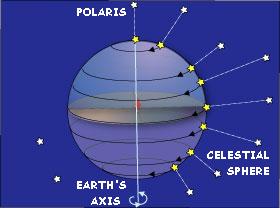 |
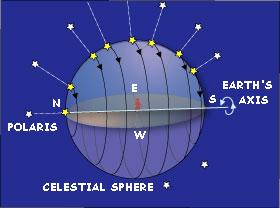 |
| The Celestial Sphere viewed from the North Pole |
The Celestial Sphere viewed from the Equator |
The Celestial Sphere as viewed from the North Pole and the Equator is shown above.
Hence, we can find the visibility of the stars from each direction in these places.
Motion of Stars from North Pole
 |
 |
| Zenith | Horizon |
Motion of Stars from Equator
 |
 |
 |
 |
| North | East | West | South |
Daily Motion of Stars in the Southern Hemisphere
When you get the opportunity, try to identify and observe some southern hemisphere constellations.
 |
 |
| Stars in the Southern Cross | Canopus |











